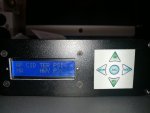Ronmar
Well-known member
- 4,154
- 7,976
- 113
- Location
- Port angeles wa
So you are using the wet tank pressure switches 115 PSI closed to 90 PSI open points to control the inflate timing? I thought about using that switch to control an indicator light on my manual panel to indicate wet tank pressure, but I find I can do it prettywell by ear. Dryer purge = full, inflate for a few seconds then pause till I hear the purge. I havnt timed it, but filling in similar pulses by hand, I am pretty sure it does not take 30 minutes to go from 20 to 80 PSI. I will time it, but 30 minutes sounds like an awfully long time for something bad to happen. If it is inflating in pulses, it should return comparable steps in pressure that could be checked as an expected result.
I would suggest something in the code to cope with leaks, like an expected pressure reading witin a certain range when you check pressure initially.
You could also read the pressure 3-4 times over a few seconds after opening the wheel valves, looking for a change in the reading. If you have one tire that is leaking, as soon as you close control and send a shot of air to open the wheel valves, the pressure measurement at the PCU will be unstable as the tire pressures equalize amongst themselves. Have seen this watching the pressure gauge connected to the PCU before I fixed a leaking wheel valve. That took care of most of the change, but I was still seeing a change in pressure after opening the valves which led me to a leak at the T fitting down by the transmission. So reading out of range(unable to open wheel valves?) or unstable indicates a leak...
I would suggest something in the code to cope with leaks, like an expected pressure reading witin a certain range when you check pressure initially.
You could also read the pressure 3-4 times over a few seconds after opening the wheel valves, looking for a change in the reading. If you have one tire that is leaking, as soon as you close control and send a shot of air to open the wheel valves, the pressure measurement at the PCU will be unstable as the tire pressures equalize amongst themselves. Have seen this watching the pressure gauge connected to the PCU before I fixed a leaking wheel valve. That took care of most of the change, but I was still seeing a change in pressure after opening the valves which led me to a leak at the T fitting down by the transmission. So reading out of range(unable to open wheel valves?) or unstable indicates a leak...
Last edited:




